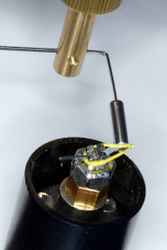
Posted to News on 4th Jul 2014, 10:20
Hexapods help measure stress in a dental model
Today, many developments would not be possible without computer-aided simulation processes. This is one of the reasons why the finite element method has become a standard tool in solid-state simulation. It can be used to calculate solutions to problems from a wide range of physical disciplines, including automobile manufacture, tool making and mechanical engineering, medical technology and the manufacture of musical instruments. However, this approach can only provide calculated - and thus fictitious - values. This is why hardware models are often also used for simulation, for biomechanical and biomedical problems in particular. Hexapods, which provide high-precision positioning with six degrees of freedom, offer interesting options for measurement set-ups used to test how well the models reproduce reality.

Hexapods have a parallel kinematic structure, i.e. six drives act together on a single moving platform. Depending on their design, Hexapods can position loads from a few kilograms to several tons with high precision in any spatial orientation in three linear and three rotational axes. The best-known application of six-axis parallel-kinematic systems is probably in flight simulators. Hexapods, suitable for applications in metrology, industry or research, are, however much more accurate. Depending on the requirements of the application, they are driven by high-precision drive screws and precisely controllable DC motors, or directly by linear motors, for example based on piezo actuators, instead of using hydraulic drives.
The advantages compared with serial, that is, stacked systems, are much better path accuracy, repeatability and flatness. In addition, the moved mass is low, enabling better dynamic performance, which is the same for all motion axes. Moreover, cable management is no longer an issue, because cables are not moved, and, last but not least, the system features a much more compact design. Nowadays a wide range of applications benefit from these advantages, including metrology, mechanical engineering, and medical technology and research. For the latter, dentistry provides a recent example.
In orthodontics, the behaviour of the tooth elastically embedded in the bone must be investigated, for example, for corrective measures. To simulate realistic tooth motions using an experimental set-up directly on the patient is, however, hardly feasible. Such an "in vivo' experiment would be highly unpleasant for the patient or test subject. Moreover, the anatomical conditions in the oral cavity are unsuitable for investigations and tests that allow verifiable statements regarding the active force system in tooth motions.
Nevertheless, the question that always needs to be answered is: which forces and torques occur, and at what magnitude? This is where simulations using the finite element method can provide answers. However, in practice they have had only limited success, because, due to the complexity of suitable FE models, the values calculated by computer are always fictitious. Thus, for example, the calculation of the biomechanical behaviour of the connective tissue of the periodontal ligament has not yet provided a clear answer.
Realistic simulations using a model
This is why scientists from the University of Ulm have used a different approach and developed a new system, designed to answer the question how the tooth embedded elastically in the jawbone behaves under stress. The result is a numerically controlled experimental set-up that allows measurements of the clinically relevant forces acting on the tooth during orthodontic tooth motion. In this way, FE models can be checked and modified on the basis of real measurements.
The biomechanical structure of the simulation system is based on a parallel-kinematic Hexapod from PI (Physik Instrumente). At a diameter of 348mm and a height of 328mm, the Hexapod is very compact. At a repeatability of +/- 1um (Z axis) and +/- 2um (X and Y axes) and thanks to the high stiffness of the overall system, this system turns out to be the well suited for simulating the small motions of a tooth in the jawbone. In addition, its pivot point inside and outside the tooth root can be freely defined, a necessary prerequisite for biomechanical simulation. The travel ranges of the Hexapod are +/- 25mm and +/- 50mm in the vertical and horizontal directions at rotating or tilt angles of +/- 30 degrees (vertical) and +/- 15 degrees (horizontal).
For the simulation, the Hexapod was combined with a force sensor mounted on a rigid rotary table. The phantom tooth, essentially an orthodontic bracket like that on a human tooth, is mounted directly at the sensor. The standardised elastic behaviour of the periodontal ligament is simulated by means of a program especially developed for this purpose. The forces and torques generated by the orthodontic apparatus to be studied act on the phantom tooth via the orthodontic bracket.
The Hexapod moves the test specimen in small steps, in order to measure the different stresses, depending on the position of the tooth. The Hexapod system is very easily controlled. The digital Hexapod controller allows the user to set a pivot point as the centre of rotation anywhere inside or outside the Hexapod work space. This freely definable pivot point is maintained, independently of the motion. The user specifies all motion commands in Cartesian coordinates, whereas all transformations to the individual drives are performed by the controller. Thanks to the high positioning accuracy, the force applied to the specimen can be exactly assigned to a position, allowing the stress points at the tooth to be accurately determined. The high stiffness of the Hexapod ensures an accurate simulation of the motion of the tooth.
Results obtained with the simulation model thus contribute to a better evaluation of the orthodontic processes in the oral cavity, and a more effective design of corrective measures. Similar results can be achieved in other areas, for example in dental and hip implants, using suitable test set-ups. Thanks to the versatility and large number of variants of parallel-kinematic Hexapods, industrial applications are also possible. To learn more, please go to www.pi.ws.
Trent House, University Way
Cranfield Technology Park
MK43 0AN
UNITED KINGDOM
+44 (0)1234 756360






























